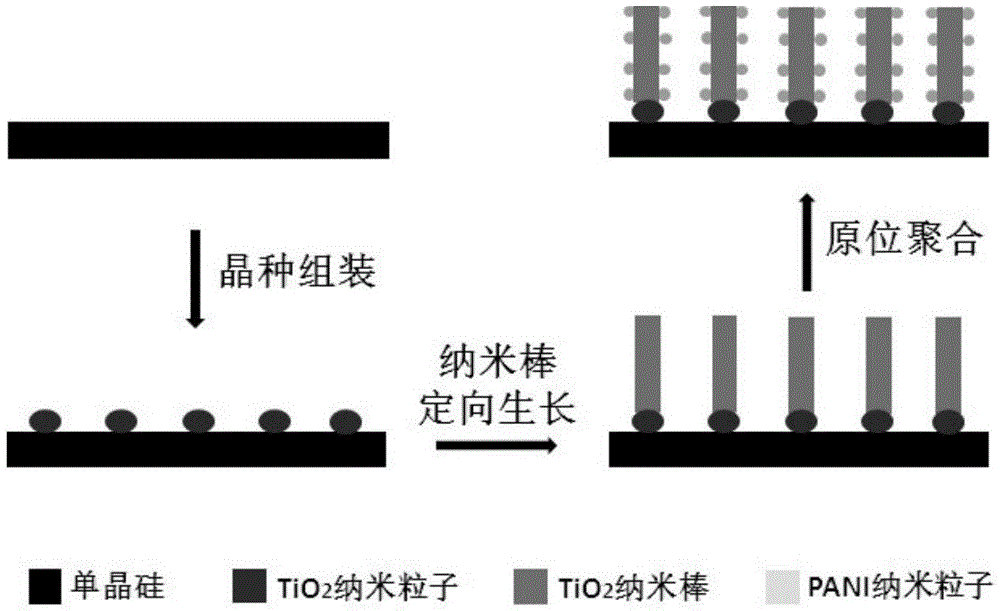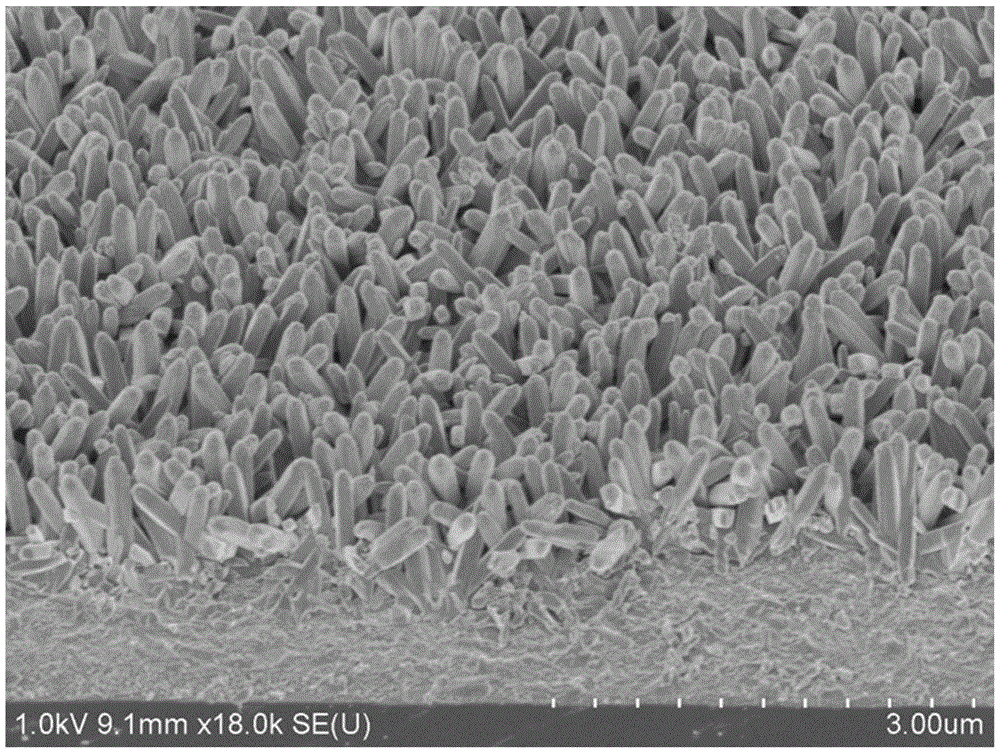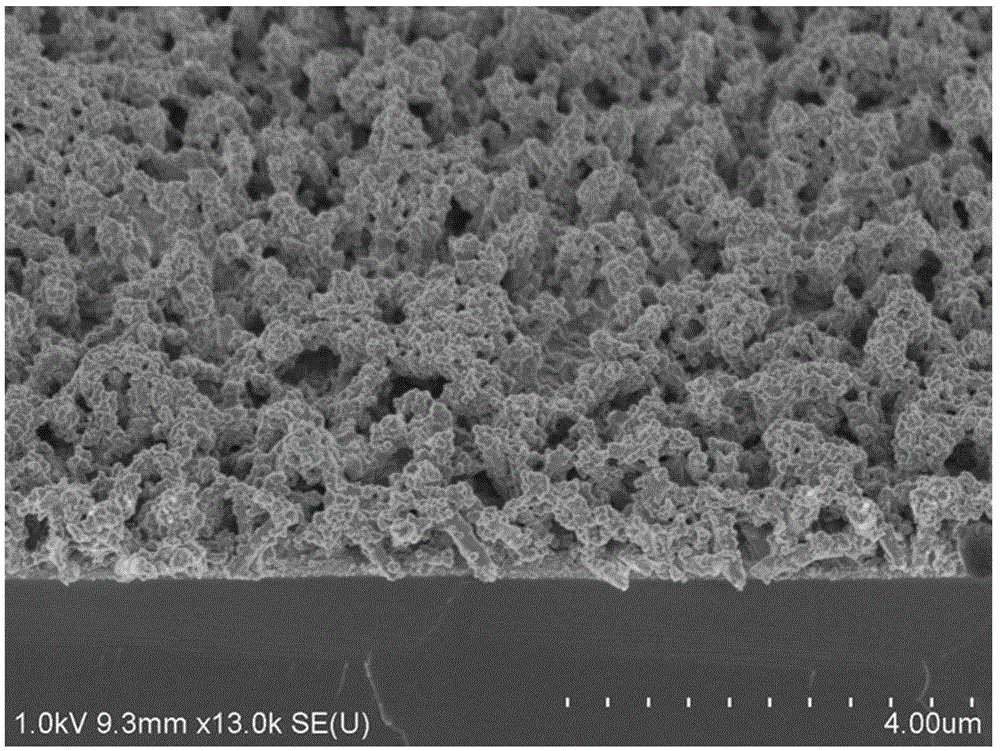Si-TiO2-PANI (silicon-titanium dioxide-polyaniline) composite material assembled based on ternary hierarchy and application thereof
A composite material, titanium dioxide technology, applied in organic compound/hydride/coordination complex catalysts, chemical instruments and methods, chemical/physical processes, etc., can solve the problems of low photoelectric conversion efficiency, easy agglomeration, and difficult recycling, etc. Achieve excellent anti-reflection performance, not easy to agglomerate, and easy to recycle
- Summary
- Abstract
- Description
- Claims
- Application Information
AI Technical Summary
Problems solved by technology
Method used
Image
Examples
Embodiment 1
[0023] Step 1: Growth of TiO on the surface of single crystal silicon 2 seed crystal
[0024] Place the wafer in NH 3 h 2 O, H 2 o 2 and H 2 In the mixed solution of O, the volume ratio is 1:1:5, the temperature is 80°C, and the heating time is 30min. Then, immerse in the isopropanol solution of tetrabutyl titanate with a concentration of 0.075mol / L for pulling, the pulling speed is 2mm / s, and the pulling is repeated 20 times. Calcined in the furnace for about 30min.
[0025] Step 2: TiO 2 Seed induced TiO 2 Preparation of nanorods
[0026] Attach TiO to the surface obtained in step 2 2 The seeded silicon wafers were placed under hydrothermal conditions to grow TiO 2 Nano stave. The hydrothermal synthesis condition is at a temperature of 130°C, and treated in a reactor filled with 10mL deionized water, 10mL concentrated hydrochloric acid (37% mass fraction) and 0.5mL tetrabutyl titanate for 8h, and then the sample was taken out and blown dry with nitrogen .
[00...
Embodiment 2
[0031] Step 1: Growth of TiO on the surface of single crystal silicon 2 seed crystal
[0032] Place the wafer in NH 3 h 2 O, H 2 o 2 and H 2 In the mixed solution of O, the volume ratio is 1:1:5, the temperature is 80°C, and the heating time is 40min. Then, immerse in the isopropanol solution of tetrabutyl titanate with a concentration of 0.05mol / L for pulling. The pulling speed is 2mm / s, and the pulling is repeated 15 times. Finally, the above sample is placed in a 450°C muffle Calcined in the furnace for about 1h.
[0033] Step 2: TiO 2 Seed induced TiO 2 Preparation of nanorods
[0034] The surface obtained in step 1 is attached with TiO 2 The seeded silicon wafers were placed under hydrothermal conditions to grow TiO 2 Nano stave. The hydrothermal synthesis condition is at a temperature of 130°C, and treated in a reactor filled with 10mL deionized water, 10mL concentrated hydrochloric acid (37% mass fraction) and 0.5mL tetrabutyl titanate for 8h, and then the s...
Embodiment 3
[0039] Step 1: Growth of TiO on the surface of single crystal silicon 2 seed crystal
[0040] Place the wafer in NH 3 h 2 O, H 2 o 2 and H 2 In the mixed solution of O, the volume ratio is 1:1:5, the temperature is 90°C, and the heating time is 30min. Then, immerse in the isopropanol solution of tetrabutyl titanate with a concentration of 0.1mol / L for pulling. The pulling speed is 2mm / s, and the pulling is repeated 10 times. Finally, the above sample is placed in a 500°C muffle Calcined in the furnace for about 30min.
[0041] Step 2: TiO 2 Seed induced TiO 2 Preparation of nanorods
[0042] The surface obtained in step 1 is attached with TiO 2 The seeded silicon wafers were placed under hydrothermal conditions to grow TiO 2 Nano stave. The hydrothermal synthesis condition is at a temperature of 120°C, and treated in a reactor filled with 10mL of deionized water, 10mL of concentrated hydrochloric acid (37% by mass) and 0.5mL of tetrabutyl titanate for 8h, and then ...
PUM
| Property | Measurement | Unit |
|---|---|---|
| The average particle size | aaaaa | aaaaa |
| The average diameter | aaaaa | aaaaa |
| Average height | aaaaa | aaaaa |
Abstract
Description
Claims
Application Information
 Login to View More
Login to View More - R&D
- Intellectual Property
- Life Sciences
- Materials
- Tech Scout
- Unparalleled Data Quality
- Higher Quality Content
- 60% Fewer Hallucinations
Browse by: Latest US Patents, China's latest patents, Technical Efficacy Thesaurus, Application Domain, Technology Topic, Popular Technical Reports.
© 2025 PatSnap. All rights reserved.Legal|Privacy policy|Modern Slavery Act Transparency Statement|Sitemap|About US| Contact US: help@patsnap.com



